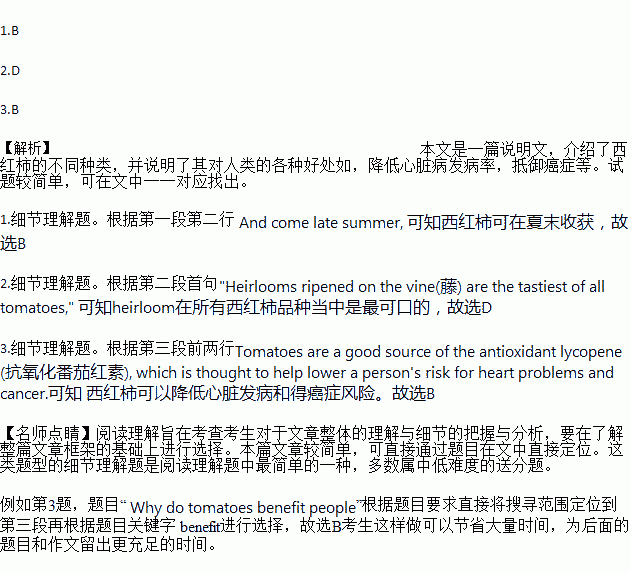题目内容
Consider the tomato: easy to grow, healthy to eat, tasty in just about any recipe and pleasant to look at. And come late summer, in steady supply. Though you can find it during the coldest winter months, August is the tomato's season to shine. Farmers' markets and grocery stores are bursting with lesser-known but arguably tastier varieties, including purple cherries and big heirlooms.

"Heirlooms ripened on the vine(藤) are the tastiest of all tomatoes," says Amy Goldman Fowler, author of The Heirloom Tomato. "I think their beauty is more than skin-deep." Heirloom seeds have been around for at least 50 years, often passed down from generation to generation. You may hear cherry or heirloom used to describe a tomato at hand, but there are many different kinds of tomatoes, and growers hav e fun giving catchy names to varieties: Mortgage Lifters, Beefsteaks, Oxhearts, Early Girls.
e fun giving catchy names to varieties: Mortgage Lifters, Beefsteaks, Oxhearts, Early Girls.
And all of them come with health benefits. Tomatoes are a good source of the antioxidant lycopene (抗氧化番茄红素), which is thought to help lower a person's risk for heart problems and cancer. Tomatoes also contain healthy vitamins(维生素) A and C. For the best fruit (they're fruits, not vegetables), choose tomatoes with shiny, firm skin and a little give, and store them at room temperature away from direct sunlight. Keep them out of the fridge, since cold temperatures can affect the original taste.
"They satisfy something more than just taste," says Fowler. "Tomatoes feed your soul."
1.In which season do tomatoes sell best?
A. Spring. B. Summer.
C. Autumn. D. Winter.
2.What can you learn from the passage?
A. Tomatoes are healthy vegetables.
B. Direct sunlight helps to store tomatoes.
C. Tomatoes go bad more quickly in the fridge.
D. Heirlooms are tastier than the other tomatoes.
3.Why do tomatoes benefit people?
A. They can produce antioxidant lycopene.
B. They may prevent some diseases.
C. They can be used as medicine.
D. They may make people's skin shiny.


 u have gained, you'll never make sound(正确的)judgments if you don't have wisdom. Wisdom comes from imagination and reflection(反省).If you can imagine the possible future outcomes of your present decisions and actions, you can avoid mistakes.And if you can reflect on the mistakes you have made, you can avoid making the same mistakes again and again.Such is wisdom.
u have gained, you'll never make sound(正确的)judgments if you don't have wisdom. Wisdom comes from imagination and reflection(反省).If you can imagine the possible future outcomes of your present decisions and actions, you can avoid mistakes.And if you can reflect on the mistakes you have made, you can avoid making the same mistakes again and again.Such is wisdom.